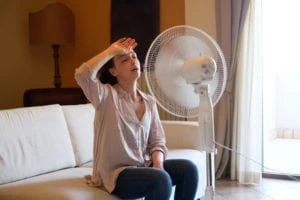Heat Pump Not Cooling? Here’s 6 Reasons Why
With temperatures already in the 80’s, we assume you’ve already tried to turn on your HVAC/air conditioner, or if you have a heat pump, that you’ve tried to switch your year-round heat pump from heating mode to cooling mode.

If you’ve just tried to switch modes to discover it won’t actually go into cooling mode, what can you do? Assume that your HVAC system has broken down completely, throw it out, and rush out to buy a new one. No, no, we’re not going to encourage that at all.
Instead, give us a call for an inspection and potential repair, and in the meantime read on to learn what could be causing this problem, and discover some possible heat pump system solutions and heat pump troubleshooting that you can do yourself, versus assuming you need a new capacitor, refrigerant charge or heat pump repair.
There’s A Problem With The Refrigerant Flow
This is the most basic answer to a heat pump that won’t switch modes—it means that the refrigerant isn’t flowing correctly, but why? If the refrigerant levels are correct and there’s not a low refrigerant situation due to refrigerant leaks, there may be other common reasons.
What happens during heat pump operation during heating mode is that refrigerant circulates through the inside and outside component of the system, and absorbs heat from the outside air and moves it indoors. When it’s supposed to switch back into cooling mode, ideally a component called the reversing valve will activate in order to help refrigerant flow in the opposite direction.
A component called a check valve is also responsible for helping the refrigerant avoid some portions it must pass through in heating mode, and vice-versa in cooling mode. So when your heat pump won’t shift from one mode to the other, it means that the refrigerant isn’t flowing correctly, and there could be one of three components to blame:
The Sliding Cylinder
Ideally, this component is supposed to kick in to reverse the flow of refrigerant once you switch your system into a different mode. While the reversing valve is responsible for enabling the refrigerant in the heat pump to do this, the sliding cylinder within the valve is vital to the whole process.
Check Valves
We mentioned this component above—it is designed to automatically prevent backflow (reverse flow) when fluid in the line reverses direction. These are self-automated components, but they can get stuck. And when that happens, refrigerant can go where it’s not supposed to go, therefore disallowing your heat pump from switching modes.
Thermostat
It’s possible your actual heat pump may not be to blame at all! You could have a faulty or even a miscalibrated thermostat. Be sure to check with our professionals to see what the root cause of your problem is, but first check your thermostat. Is the temperature displaying correctly? Is it set to cooling mode? Even the Comfort Bear can be forgetful every now and then—it’s always best to double check!
Airflow
Airflow is absolutely critical for any HVAC system, and when there is a reduction in airflow it can cause issues throughout your air conditioning system, some of which can get so bad it will require the expertise of a HVAC technician to come out and perform a HVAC service call.
Dirty air filters can cause this kind of heat pump problem. Homeowners need to watch for buildup in many areas of their HVAC system or heat pump, including their outdoor unit, central air system’s components such as condensers, compressors, air handlers, evaporator coils, and of course, clogged filters.
If the outside unit has dirty coils, it can cause a reduction in performance and an increase in energy bills, where your cold air turns to cool air, then ultimately to warm air. Maintaining your outdoor coils should be part of any regular maintenance plan.
Circuit Breakers
Whether it’s the blower motor, refrigerant pump, or many other parts of HVAC systems and heat pumps, having a solid electrical connection is vital to the operation of your air conditioner. If there was something that overloaded the system and caused a circuit breaker to trip, it can cause the system to not function. You can typically check your electrical panel and look for any breakers that are labeled for your HVAC system, and see if they are in the OFF position.
If you’re unsure, please contact a professional for help in Oak Grove MO, Olathe KS, St. Joseph MO, and more.
We hope these troubleshooting tips for common problems we encounter with heat pump cooling and heating systems will help you get through the seasons.
For Comfort and Care from the Team with the Bear, contact Climate Control Heating and Cooling, Inc. We can handle all your heat pump needs, including expert air conditioning repair in Kansas City, MO.




